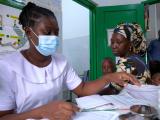Mar 29, 2013
Study on number/timing of childhood vaccines says no connection to autism
Neither the number of vaccines given to young children nor the timing of vaccinations confers any increased risk of autism, according to a large government study published today in the Journal of Pediatrics. The authors analyzed the medical records of 256 children with autism spectrum disorder (ASD) and 752 children without ASD born between 1994 and 1999. To determine exposure to antigens in the children, they added up the antibody-stimulating proteins and polysaccharides contained in the vaccines each child had received during a single doctor's visit as well as the cumulative number in all vaccines each child had received in the first 2 years of life. No difference was found in either the maximum number received in a day or the total number over 2 years between children with and without ASD. The authors point out that infants are exposed to many bacteria and viruses naturally from the time of birth and that the relatively small number of antigens contained in vaccines would not be expected to have a particular effect on the immune system. They also say that although the current vaccination schedule for young children contains more vaccines than were recommended in the late 1990s, the number of antigens in the vaccines has dropped substantially: In 2012, the maximum to which a child could be exposed by age 2 was 315, compared with several thousand in the late 1990s. Vanderbilt University pediatrics professor Ellen Wright Clayton said in a Minnesota Public Radio story on the study that with researchers focusing on whether vaccines cause ASD, they are "missing the opportunity to look at what the real causes are. They're not vaccines."
Mar 29 J Pediatr press release
Mar 29 MPR story on the study
Pakistan applies pressure in tribal regions to resume polio vaccination
Government officials are applying political and financial pressure to tribal leaders opposed to polio vaccination campaigns in Pakistan's tumultuous North Waziristan Agency, according to IRIN, the United Nations humanitarian news agency. In addition, parents are traveling long distances to have their children immunized, the story said. Around 200,000 children remain unvaccinated as a result of local bans in North and South Waziristan, federal health official Mazhar Nisar told IRIN. Nizar said the ban in South Waziristan has been "somewhat relaxed," and officials are "attempting to talk to tribal elders and sort out matters so anti-polio drives could resume." In addition to negotiations, the government imposed measures to deny tribal people of North Waziristan passports, national identity cards, and other official documents if community leaders don't overturn the ban. A small honorarium to tribal elders was also stopped and development work in some areas suspended. Pakistan is one of three nations where polio remains endemic, with Afghanistan and Nigeria.
Mar 28 IRIN story
CDC releases its first guidelines on managing Q fever
The US Centers for Disease Control and Prevention (CDC) this week released its first set of national guidelines for the diagnosis and management of Q fever, a zoonotic disease caused by the bacterium Coxiella burnettii. The pathogen is listed by the CDC as a Category B bioterrorism agent, meaning it is moderately easy to disseminate and causes moderate morbidity and low mortality. Because diagnosing Q fever is difficult, it has long been considered an underreported illness, the CDC says. Infection is usually caused by inhaling bacteria from animal waste or soil, and the disease is an occupational risk for farmers and others who work with livestock. Acute Q fever symptoms vary, but patients typically have a nonspecific febrile illness, hepatitis, or pneumonia, which can persist for weeks or months if untreated. Chronic Q fever, which is rare, involves endocarditis that is fatal if not treated. The disease became reportable in 1999, and reported cases increased after that, reaching 167 in 2008, the CDC says. The recommendations cover recognition, clinical and laboratory diagnosis, treatment, management, and reporting for healthcare and public health personnel. They were published as part of the Recommendations and Reports series in today's Morbidity and Mortality Weekly Report.
Mar 29 CDC Q fever recommendations
Study: Recent human H3N2 infection does not protect pigs from swine H3N2
Prior infection with an older human influenza A/H3N2 influenza strain protected pigs against a swine H3N2 strain, but prior infection with a recent human H3N2 strain did not, which demonstrates the antigenic divergence between swine and human strains, according to a study yesterday in Influenza and Other Respiratory Viruses. Belgian researchers studied swine that had been infected with either a 1975 human H3N2 strain, a 2005 human H3N2 strain, or a 2008 swine H3N2 strain. They inoculated all groups plus control pigs with the 2008 swine H3N2 strain and found that those previously infected with the 1975 human and 2008 swine strains to be completely protected. Those previously infected with the 2005 human strain, however, showed respiratory-virus titers similar to those in controls, but their mean duration of nasal virus shedding was a day shorter. The researchers say the results may shed light on recent US infections in people with a swine-origin H3N2 variant.
Mar 28 Influenza Other Respi Viruses abstract



















